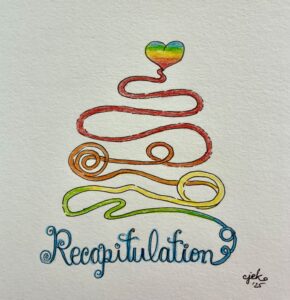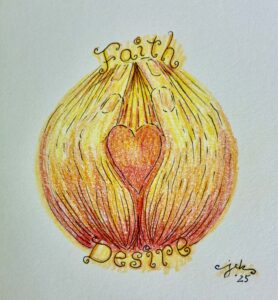
-Artwork © 2025 Jan Ketchel
“Use your words,” is the instruction we give the frustrated child. Words are magic, they make things happen.
“Name your Good!” would exclaim Emma Curtis Hopkins of New Thought fame. Your good is what you truly want, the Truth of your Spirit. To boldly state it is to fully claim it.
State your intent loudly, even in your dreams, counseled the shamans of ancient Mexico, and the word will truly become the flesh.
One method of achieving your dreams and your good is to recapitulate your life thus far lived, to bring to consciousness all the things that stand in the way of achieving your dreams and settling them once and for all. Perhaps these things entail repressed memories that inhibit fully living life, or old fears from childhood, or some trauma—physical, mental, spiritual or emotional—that intercepted the unfolding of life.
To state the intent to recapitulate your life activates the subconscious mind to initiate your very personal soul retrieval journey. First of all, with all due respect to Bessel van der Kolk, it is the subconscious mind that keeps the score. The subconscious mind stores one’s full personal history in the compartments it creates within the physical body, some of them, like a simple breath, quite constricting.
Although the subconscious mind stores all the minutia of every moment of life, it also stores and denies consciousness access to experiences that have traumatized, and therefore threatened, the overall growth of our being at different stages of our lives. Some of these truths remain secrets to the self until the life review at the completion of human life.
Under the powerful influence of the survival instinct, the subconscious mind dissociates us from knowing and integrating the threatening experiences it secretly stores, and thus we lose access to parts of our soul, often to the point of complete amnesia of them.
When we state the suggestion to the subconscious mind to recapitulate, however, we are overriding the influence of the survival instinct to keep us in the dark about our darkest hours. We now claim conscious responsibility to manage our wholeness.
To assume that responsibility we must fully know, and thus fully experience, the wholeness of our soul’s journey in this life and, sometimes, even beyond it. Once the suggestion to recapitulate has been accepted by the subconscious mind as its working premise, it will bring forth to consciousness the opportunity for retrieval of lost experiences in the most necessary and effectual order.
Thus, the order of memory retrieval is not within conscious control; it rests with the judgment of the subconscious mind. This judgment is not analytic. It is in full keeping with achieving its accepted operating premise, to recapitulate. What is under conscious control is to fully show up for the journey, even if it is unpleasant and doesn’t proceed in the orderly fashion that the ego would prefer.
The shamans of ancient Mexico recommended bilateral breathing, as one ventures into encounters with one’s unknown soul experiences, to steady the presence of the conscious mind as it relives and integrates its forsaken experiences. EMDR utilizes the same bilateral grounding and integrating mechanism.
In addition to the practice of recapitulation of memory, is the actual usurpation of all current life experience by the subconscious mind as its playing field, in an effort to lead consciousness to the experiences which must be retrieved. Be forewarned, to state the intent to recapitulate activates a soul journey that shows up in all arenas of life.
Several advantages of the impact of recapitulation upon the concurrent events in our lives is that we learn to read energy; synchronicities abound that attract our attention; interactions reveal necessary encounters; physical symptoms take on new meaning. Our whole world opens up and we are offered a myriad of experiences we might otherwise never encounter. Everything is used to further guide us to knowledge and experiences that are crucial to full soul retrieval.
As powerful as these intrusions may be, consciousness does have the prerogative to insist upon a break. State the intention to take a break, with the clear agreement that you will return to the work shortly. Be sure to follow through on your end of the bargain. The subconscious can be quite a task master. It insists upon a responsible adult partner.
Often, people state firmly to the subconscious mind their Good—their deepest heartfelt desire—not realizing that they are also initiating the intent to recapitulate, as in order to fulfill their desire they must first retrieve their soul. We cannot have fulfillment with half our soul lost to us.
The subconscious necessarily plots a course, which first enables us to retrieve the necessary parts of ourselves and to then be able to materialize our sought after dream. Many people become quite discouraged with the physical results of their stated suggestions and must be awakened to the deeper process of soul retrieval fundamental to their stated intent.
Soul retrieval neutralizes the old defenses that were once necessary to protect fragility. Until retrieved, dissociated parts construct their own lives with the core premise that they remain in hiding. The disabling effects of these parts upon conscious integration makes it critical that they be known and integrated as foundational to the desired growth of the conscious mind.
As soon as you state the intent to recapitulate, the journey has begun. The adult self is clearly using its words and assuming responsibility for showing up for the journey, the full journey.
The journey, though at times quite excruciating, is always magical and filled with awe. It is the journey we all will ultimately take, but we have the opportunity to take it right now! So why wait?!
Use your words, declare your Good!
Chuck



